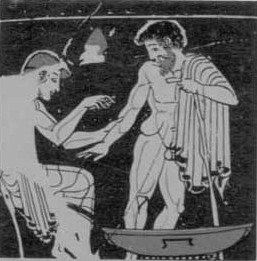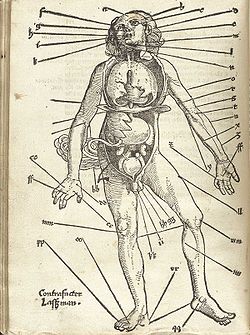Bloodletting
- Blood donation is about donating blood; it does not affect the health of the person donating.


Historical medical practice involving withdrawal of blood
Introduction[edit]
Bloodletting is an ancient medical practice that involves the withdrawal of blood from a patient to treat or prevent illness. Historically, it was based on the concept of humoral theory, which suggested that the body contained four primary humors—blood, phlegm, black bile, and yellow bile—and that an imbalance of these fluids led to disease.
Bloodletting was practiced for thousands of years across many civilizations, including Ancient Egypt, Greece, Rome, China, and the Islamic world. Although largely abandoned in modern medicine, bloodletting is still used in specific medical conditions such as hemochromatosis and polycythemia vera.
Historical Background[edit]
Bloodletting was a dominant practice in traditional medicine for over 2,000 years. It was believed to purge impurities and restore balance to the body's humors. The technique evolved from sacrificial rituals in early civilizations to a systematic medical procedure during the time of Hippocrates and Galen.
Ancient Civilizations[edit]
- Egyptians: Used bloodletting as part of religious purification rituals.
- Greeks and Romans: Hippocrates (460–370 BCE) and Galen (129–216 CE) promoted bloodletting based on humoral theory.
- Islamic Medicine: Influential scholars like Avicenna incorporated bloodletting into medical practice.
- Chinese Medicine: Used a form of bloodletting known as wet cupping, which is still practiced today.
Medieval and Renaissance Periods[edit]
During the Middle Ages, bloodletting became widespread in Europe, often performed by barber-surgeons. The red and white barber pole is a remnant of this tradition, symbolizing blood and bandages.
In the Renaissance, figures like Andreas Vesalius and William Harvey began questioning its effectiveness, though bloodletting remained common.
18th and 19th Centuries[edit]
Despite increasing skepticism, bloodletting was still a mainstay of medical treatment. Prominent figures such as George Washington were subjected to aggressive bloodletting, often with fatal consequences.
By the late 19th century, advances in medicine, particularly the germ theory of disease, led to the gradual decline of bloodletting as a standard treatment.
Methods of Bloodletting[edit]
Several techniques were used in historical bloodletting, each with different instruments and approaches:
- Venesection (Phlebotomy): The most common method, involving cutting a vein and allowing blood to flow into a container.
- Cupping Therapy: Involved applying heated glass cups to the skin to create suction and draw blood to the surface.
- Leech Therapy (Hirudotherapy): Used medicinal leeches (Hirudo medicinalis) to remove blood.
- Scarification: Small incisions were made on the skin, followed by suction to draw out blood.
- Arteriotomy: A rare method involving the cutting of an artery rather than a vein.
Medical Uses in Modern Medicine[edit]
While largely obsolete, bloodletting still has limited medical applications today:
Phlebotomy for Blood Disorders[edit]
Modern bloodletting, known as therapeutic phlebotomy, is used to treat specific conditions, including:
- Hemochromatosis: A genetic disorder causing excess iron accumulation in the body.
- Polycythemia vera: A condition in which the bone marrow produces too many red blood cells.
- Porphyria cutanea tarda: A disorder involving the accumulation of porphyrins, leading to skin sensitivity.
Leech Therapy[edit]
Medicinal leeches are still used in microsurgery to:
- Improve circulation in skin grafts.
- Prevent blood clotting in reattached limbs or digits.
- Reduce swelling and venous congestion.
Decline and Scientific Criticism[edit]
By the 19th century, scientific advancements disproved the efficacy of bloodletting for most conditions. Several factors contributed to its decline:
- Discovery of Germ Theory – Proved that diseases were caused by microorganisms, not humoral imbalances.
- Advancements in Pathology – Showed that removing blood did not treat infections or fevers.
- Increased Mortality Studies – Demonstrated that excessive bloodletting led to shock, anemia, and death.
Bloodletting in Alternative Medicine[edit]
Despite its rejection in mainstream medicine, bloodletting remains popular in some alternative practices, including:
- Traditional Chinese Medicine (TCM) – Wet cupping is still used to remove "stagnant blood."
- Ayurvedic Medicine – Some Indian practitioners use bloodletting as part of Panchakarma detoxification.
- Unani Medicine – Practiced in parts of the Middle East and South Asia.
Cultural and Religious Significance[edit]
Bloodletting has also played a role in religious and cultural traditions:
- In Islamic tradition, hijama (cupping therapy) is practiced for spiritual and physical healing.
- In Christian medieval Europe, bloodletting was seen as a form of purification.
- In some tribal cultures, bloodletting was used as part of initiation rites.
See Also[edit]
External Links[edit]
- NCBI – Historical Perspectives on Bloodletting
- American Medical Association – Medical History Resources
|
|
|
Ad. Transform your life with W8MD's Budget GLP-1 injections from $75


W8MD offers a medical weight loss program to lose weight in Philadelphia. Our physician-supervised medical weight loss provides:
- Weight loss injections in NYC (generic and brand names):
- Zepbound / Mounjaro, Wegovy / Ozempic, Saxenda
- Most insurances accepted or discounted self-pay rates. We will obtain insurance prior authorizations if needed.
- Generic GLP1 weight loss injections from $75 for the starting dose.
- Also offer prescription weight loss medications including Phentermine, Qsymia, Diethylpropion, Contrave etc.
NYC weight loss doctor appointmentsNYC weight loss doctor appointments
Start your NYC weight loss journey today at our NYC medical weight loss and Philadelphia medical weight loss clinics.
- Call 718-946-5500 to lose weight in NYC or for medical weight loss in Philadelphia 215-676-2334.
- Tags:NYC medical weight loss, Philadelphia lose weight Zepbound NYC, Budget GLP1 weight loss injections, Wegovy Philadelphia, Wegovy NYC, Philadelphia medical weight loss, Brookly weight loss and Wegovy NYC
|
WikiMD's Wellness Encyclopedia |
| Let Food Be Thy Medicine Medicine Thy Food - Hippocrates |
Medical Disclaimer: WikiMD is not a substitute for professional medical advice. The information on WikiMD is provided as an information resource only, may be incorrect, outdated or misleading, and is not to be used or relied on for any diagnostic or treatment purposes. Please consult your health care provider before making any healthcare decisions or for guidance about a specific medical condition. WikiMD expressly disclaims responsibility, and shall have no liability, for any damages, loss, injury, or liability whatsoever suffered as a result of your reliance on the information contained in this site. By visiting this site you agree to the foregoing terms and conditions, which may from time to time be changed or supplemented by WikiMD. If you do not agree to the foregoing terms and conditions, you should not enter or use this site. See full disclaimer.
Credits:Most images are courtesy of Wikimedia commons, and templates, categories Wikipedia, licensed under CC BY SA or similar.
Translate this page: - East Asian
中文,
日本,
한국어,
South Asian
हिन्दी,
தமிழ்,
తెలుగు,
Urdu,
ಕನ್ನಡ,
Southeast Asian
Indonesian,
Vietnamese,
Thai,
မြန်မာဘာသာ,
বাংলা
European
español,
Deutsch,
français,
Greek,
português do Brasil,
polski,
română,
русский,
Nederlands,
norsk,
svenska,
suomi,
Italian
Middle Eastern & African
عربى,
Turkish,
Persian,
Hebrew,
Afrikaans,
isiZulu,
Kiswahili,
Other
Bulgarian,
Hungarian,
Czech,
Swedish,
മലയാളം,
मराठी,
ਪੰਜਾਬੀ,
ગુજરાતી,
Portuguese,
Ukrainian


